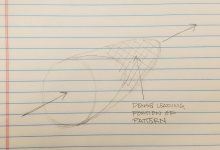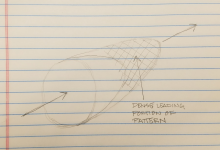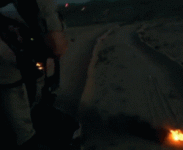You are using an out of date browser. It may not display this or other websites correctly.
You should upgrade or use an alternative browser.
You should upgrade or use an alternative browser.
Shot string video.
- Thread starter Lefty76
- Start date
Winchester30
Active member
Is there a TikTok version? 30 mins is a bit long.
Tuckr2
Active member
Outstandng video. Really opens the mind to shotgunning in the field. Looking forward to follow on videos. This has the potential to change the way we hunt, shells, chokes, wads, patterning. Happy to see my Winchester SX4 as the test shotgun.I found this to be a very interesting video. Thought some of you might, too.
LittleBigHorn22
Well-known member
Very cool to see that in action. I do hope he shows a non side on angle so we see the full 3d effect. Looking forward to his other videos.
Pheasants & a Lab
Member
I just watched this and am glad someone started a thread. I will always go with shoot what you are confident with and what kills BUT having just bought some Boss shorties, I was a bit amazed at how long the shot string was compared to others. I think I'm a short shot string guy and Boss was twice as long. Lost of variables not explained but will be fun to watch in the future, like I need more things to clog up my brain when I pull the trigger!
goldenboy
Well-known member
I watched the video as well. One question I have is this. Okay we all know a shot string is longer than just a round ball of pellets. But how quickly does that shot string go through a pheasant flying at a 90 degree angle to me? In other words what is my margin for error from the front of the string to the back on a crossing target?
A5 Sweet 16
Well-known member
Bahaha. Thinking about the same thing at the same time. Joel, ask & ye shall receive!
Really cool stuff. I'm glad somebody has time to investigate it using modern technology. I wish somebody could do this for the most common factory loads & publish average shot string lengths for those loads in popular gun/choke combinations. Then....somehow determine which pellets seem to lead & which seem to lag, as they relate to the inner & outer portions of a pattern "circle" (my guess is the "outer" pellets tend to lag). Then....what percentage of the pattern is in the leading 1/2 of a shot string. It may sound like I'm making light of the whole issue, but I'm really not. It's neat stuff & I love thinking about it. But I've got what I feel are more important things to worry about, like how do I get 10 yards closer to a pheasant before he notices me & starts evading me? Or how do I shoot my shotgun better? Take a perfect 90-degree crossing rooster at 40 yds, flying 40 mph. That's rare in my hunting & I'd consider it approaching worst case. If my pellets are flying 700 ft/sec at 40 yds (pretty realistic for many "pheasant loads" per KPY Shotshell Ballistics program), & my shot string is 10 feet long at that point, the rooster will only fly 10 inches in the time it takes (0.0143 seconds) the last pellets to finally reach 40 yds. 10 inches. And my pattern is maybe 48" wide at that point. I find shot string interesting, but fairly insignificant. But....I'm glad to know kind of what to expect. Probably something in the 8'-12' range at 40 yds. Otherwise, I'd probably worry too much about it.
Really cool stuff. I'm glad somebody has time to investigate it using modern technology. I wish somebody could do this for the most common factory loads & publish average shot string lengths for those loads in popular gun/choke combinations. Then....somehow determine which pellets seem to lead & which seem to lag, as they relate to the inner & outer portions of a pattern "circle" (my guess is the "outer" pellets tend to lag). Then....what percentage of the pattern is in the leading 1/2 of a shot string. It may sound like I'm making light of the whole issue, but I'm really not. It's neat stuff & I love thinking about it. But I've got what I feel are more important things to worry about, like how do I get 10 yards closer to a pheasant before he notices me & starts evading me? Or how do I shoot my shotgun better? Take a perfect 90-degree crossing rooster at 40 yds, flying 40 mph. That's rare in my hunting & I'd consider it approaching worst case. If my pellets are flying 700 ft/sec at 40 yds (pretty realistic for many "pheasant loads" per KPY Shotshell Ballistics program), & my shot string is 10 feet long at that point, the rooster will only fly 10 inches in the time it takes (0.0143 seconds) the last pellets to finally reach 40 yds. 10 inches. And my pattern is maybe 48" wide at that point. I find shot string interesting, but fairly insignificant. But....I'm glad to know kind of what to expect. Probably something in the 8'-12' range at 40 yds. Otherwise, I'd probably worry too much about it.
Last edited:
goldenboy
Well-known member
Great insight Brent. That was my thinking 10" at 40 yards, less at 25! But the thing I teach new shooters or new people to the game farm is that the shot string is real. What it teaches them is to lead a bird. Most point at the bird or under the bird as it rises and never hit the bird. Once they learn how far you can lead a bird, especially at 40 yards then they start to find more success.Bahaha. Joel, ask & ye shall receive!
Really cool stuff. I'm glad somebody has time to investigate it using modern technology. I wish somebody could do this for the most common factory loads & publish average shot string lengths for those loads in popular gun/choke combinations. Then....somehow determine which pellets seem to lead & which seem to lag, as they relate to the inner & outer portions of a pattern "circle" (my guess is the "outer" pellets tend to lag). Then....what percentage of the pattern is in the leading 1/2 of a shot string. It may sound like I'm making light of the whole issue, but I'm really not. It's neat stuff & I love thinking about it. But I've got what I feel are more important things to worry about, like how do I get 10 yards closer to a pheasant before he notices me & starts evading me? Or how do I shoot my shotgun better? Take a perfect 90-degree crossing rooster at 40 yds, flying 40 mph. That's rare in my hunting & I'd consider it approaching worst case. If my pellets are flying 700 ft/sec at 40 yds (pretty realistic for many "pheasant loads" per KPY Shotshell Ballistics program), & my shot string is 10 feet long at that point, the rooster will only fly 10 inches in the time it takes (0.0143 seconds) the last pellets to finally reach 40 yds. 10 inches. And my pattern is maybe 48" wide at that point. I find shot string interesting, but fairly insignificant. But....I'm glad I know kind of what to expect. Probably something in the 8'-12' range at 40 yds. Otherwise, I'd probably worry too much about it.
Bahaha. Joel, ask & ye shall receive!
Really cool stuff. I'm glad somebody has time to investigate it using modern technology. I wish somebody could do this for the most common factory loads & publish average shot string lengths for those loads in popular gun/choke combinations. Then....somehow determine which pellets seem to lead & which seem to lag, as they relate to the inner & outer portions of a pattern "circle" (my guess is the "outer" pellets tend to lag). Then....what percentage of the pattern is in the leading 1/2 of a shot string. It may sound like I'm making light of the whole issue, but I'm really not. It's neat stuff & I love thinking about it. But I've got what I feel are more important things to worry about, like how do I get 10 yards closer to a pheasant before he notices me & starts evading me? Or how do I shoot my shotgun better? Take a perfect 90-degree crossing rooster at 40 yds, flying 40 mph. That's rare in my hunting & I'd consider it approaching worst case. If my pellets are flying 700 ft/sec at 40 yds (pretty realistic for many "pheasant loads" per KPY Shotshell Ballistics program), & my shot string is 10 feet long at that point, the rooster will only fly 10 inches in the time it takes (0.0143 seconds) the last pellets to finally reach 40 yds. 10 inches. And my pattern is maybe 48" wide at that point. I find shot string interesting, but fairly insignificant. But....I'm glad I know kind of what to expect. Probably something in the 8'-12' range at 40 yds. Otherwise, I'd probably worry too much about it.
I was curious of how much different the 11' vs 16' shot string lengths he reported would make so ran the numbers in similar fashion: It would result in about a 5" difference between the two (in terms of how far a bird flies through the shot string), 11" vs 16" of bird crossing distance. Keep in mind that you are leading the bird in the realm of 10' at that distance and crossing speed. Assuming you would want to center your shot string on the bird, you would go for the middle and adjust your 'aim' (I know, 'point') by 2.5" left/right. I cannot imagine anyone can make out 122.5" vs 120" of lead at 40 yds to toss your 4' pattern at. If you are that good, just use the 410 full choke single shot on those 40 yd crossing shots.
My takeaway is that it all comes out in the wash. In the extreme scenario above it effectively makes your 48" round pattern (at the bird strike zone) into a 48x59" oval or 48x64" oval, depending on the 11' vs 16' string length. But shot density changes as well so similar effect as playing with chokes - tradeoff pattern area vs shot density.
Your shot success is going to be much more impacted by where you aim (correct lead) than the shot string length.
Having said all that - cool video and fun to see how the wad peels back and the string develops. This gives me another excuse to use this year when I miss: 'Damn, shot string is too short on these shells'...
Bonus points if anyone can find any videos of that guy that had his wife drive the family station wagon by as he blasted away towards her.
Tuckr2
Active member
I love all the thoughts coming from this. I just want to know if they can develop me a shot that the stream lights up as it goes out to the bird. Then I know why I’m still missing these dang flying things and by how much. Over the years I’ve gotten better just mostly based on patterning my shotgun and loads - putting the majority of my pattern in front of the bird. Still suffer - especially left to right hand shots.
i suppose if they were to make sparkly shot and everyone was killing everything it wouldn’t be fun hunting anymore.
i suppose if they were to make sparkly shot and everyone was killing everything it wouldn’t be fun hunting anymore.
Last edited:
A5 Sweet 16
Well-known member
This is neither here nor there, but I'd love to see a 3D model of a shot string/pattern.
This is from the video. A fairly common representation of it.

But I'll bet it looks more like this. A dense, leading portion of a cone. As you get further back in the string, the center thins out, & most pellets are around the perimeter. The 2D stuff is great, but if we want real world data, let's have it, YouTubers!!

This is from the video. A fairly common representation of it.

But I'll bet it looks more like this. A dense, leading portion of a cone. As you get further back in the string, the center thins out, & most pellets are around the perimeter. The 2D stuff is great, but if we want real world data, let's have it, YouTubers!!

mmmm... waffle cone
Winchester30
Active member
goldenboy
Well-known member
Tuckr2 They do make one! I bought some "tracer" shot shelld for my daughter when she was shooting trap so she could see where her shot was in reference to the clay pigeon. They come in either black tracer or orage!I love all the thoughts coming from this. I just want to know if they can develop me a shot that the stream lights up as it goes out to the bird. Then I know why I’m still missing these dang flying things and by how much. Over the years I’ve gotten better just mostly based on patterning my shotgun and loads - putting the majority of my pattern in front of the bird. Still suffer - especially left to right hand shots.
i suppose if they were to make sparkly shot and everyone was killing everything it wouldn’t be fun hunting anymore.
I thought they stopped making this several years ago?Tuckr2 They do make one! I bought some "tracer" shot shelld for my daughter when she was shooting trap so she could see where her shot was in reference to the clay pigeon. They come in either black tracer or orage!
goldenboy
Well-known member
I don't know, maybe they did. But is was a great tool for my daughter.I thought they stopped making this several years ago?
Bob Peters
Well-known member
I've really nerded out on this subject, and from everything I've read and seen, the shotstring is there, but it in no way helps you. And a shorter shot string is always better. You have a lot of leeway with your pattern, and that is what hits your target. Shot string really only has any effect on very long hard crossing targets, and even then the effect is minimal and not worth worrying about. Just my thoughts on it, but I always keep an open mind.
LittleBigHorn22
Well-known member
Yeah I agree and I think the math supports it. The shot string passes by too fast for nearly all loads for it to do anything major. Especially for upland birds where direct fast crossers is relatively rare. It really think it is just statistically insignificant such that if you had 100 shooters with a 5ft load and 100 shooters with 15ft load, you simply wouldn't see any difference in success rates. Pattern on the board is just way more important to worry about. Which is good since that is easier to test.I've really nerded out on this subject, and from everything I've read and seen, the shotstring is there, but it in no way helps you. And a shorter shot string is always better. You have a lot of leeway with your pattern, and that is what hits your target. Shot string really only has any effect on very long hard crossing targets, and even then the effect is minimal and not worth worrying about. Just my thoughts on it, but I always keep an open mind.
But I would love to see a gell block being shot in slow mo while it's going 35mph to really see the dynamics.


